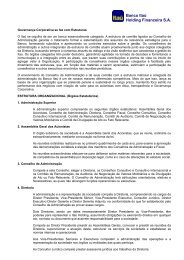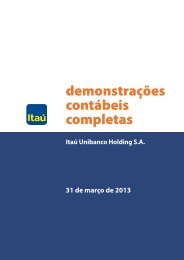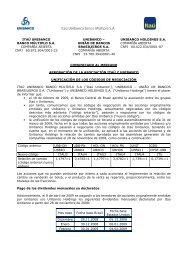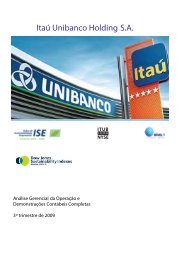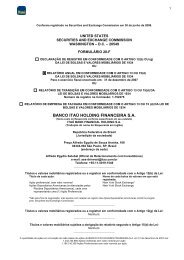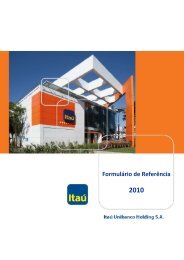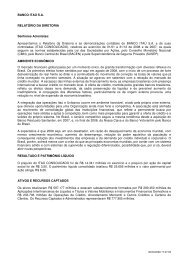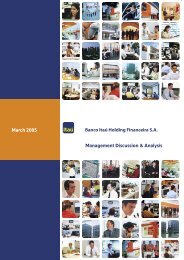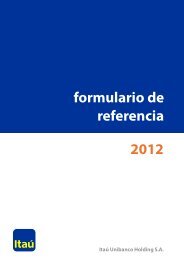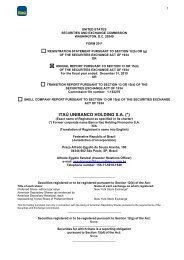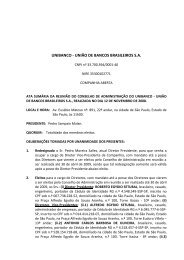MD&A and Financial Statements (PDF) - Banco Itaú
MD&A and Financial Statements (PDF) - Banco Itaú
MD&A and Financial Statements (PDF) - Banco Itaú
Create successful ePaper yourself
Turn your PDF publications into a flip-book with our unique Google optimized e-Paper software.
NOTE 4 – SUMMARY OF THE MAIN ACCOUNTING PRACTICES<br />
a) Cash <strong>and</strong> cash equivalents - For purposes of Consolidated Statement of Cash Flows, it includes cash <strong>and</strong><br />
current accounts in banks (considered in the heading cash <strong>and</strong> cash equivalents), interbank deposits <strong>and</strong><br />
securities purchased under agreements to resell – funded position that have original maturities of up to 90<br />
days or less.<br />
b) Interbank investments, remunerated restricted credits – Brazilian Central Bank, remunerated<br />
deposits, deposits received under securities repurchase agreements, funds from acceptance <strong>and</strong><br />
issuance of securities, borrowings <strong>and</strong> onlendings, subordinated debt <strong>and</strong> other receivables <strong>and</strong><br />
payables – Transactions subject to monetary correction <strong>and</strong> foreign exchange variation <strong>and</strong> operations with<br />
fixed charges are recorded at present value, net of the transaction costs incurred, calculated “pro rata die”<br />
based on the effective rate of transactions, according to CVM Resolution No. 556 of November 12, 2008.<br />
c) Securities - Recorded at cost of acquisition restated by the index <strong>and</strong>/or effective interest rate <strong>and</strong><br />
presented in the Balance Sheet, according to BACEN Circular No. 3,068, of November 8, 2001. Securities<br />
are classified into the following categories:<br />
• Trading securities – acquired to be actively <strong>and</strong> frequently traded, <strong>and</strong> adjusted to market value, with a<br />
contra-entry to the results for the period;<br />
• Available-for-sale securities – securities that can be negotiated but are not acquired to be actively <strong>and</strong><br />
frequently traded. They are adjusted to their market value with a contra-entry to an account disclosed in<br />
stockholders’ equity;<br />
• Held-to-maturity securities – securities, except for non-redeemable shares, for which the bank has the<br />
financial condition <strong>and</strong> intends or is required to hold them in the portfolio up to their maturity, are recorded<br />
at cost of acquisition, or market value, whenever these are transferred from another category. The<br />
securities are adjusted up to their maturity date, not being adjusted to market value.<br />
Gains <strong>and</strong> losses on available-for-sale securities, when realized, are recognized at the trading date in the<br />
statement of income, with a contra-entry to a specific stockholders’ equity account.<br />
Decreases in the market value of available-for-sale <strong>and</strong> held-to-maturity securities below their related costs,<br />
resulting from non-temporary reasons, are recorded in results as realized losses.<br />
d) Derivative financial instruments - these are classified on the date of their acquisition, according to<br />
management's intention of using them either as a hedge or not, according to BACEN Circular No. 3,082, of<br />
January 30, 2002. Transactions involving financial instruments, carried out upon the client’s request, for their<br />
own account, or which do not comply with the hedging criteria (mainly derivatives used to manage the overall<br />
risk exposure), are stated at market value, including realized <strong>and</strong> unrealized gains <strong>and</strong> losses, which are<br />
recorded directly in the statement of income.<br />
The derivatives used for protection against risk exposure or to modify the characteristics of financial assets<br />
<strong>and</strong> liabilities, which have changes in market value highly associated with those of the items being protected<br />
at the beginning <strong>and</strong> throughout the duration of the contract, <strong>and</strong> which are found effective to reduce the risk<br />
related to the exposure being protected, are classified as a hedge, in accordance with their nature:<br />
• Market Risk Hedge – financial assets <strong>and</strong> liabilities, as well as their related financial instruments, are<br />
accounted for at their market value plus realized <strong>and</strong> unrealized gains <strong>and</strong> losses, which are recorded<br />
directly in the statement of income.<br />
<strong>Itaú</strong> Unibanco S.A. – - September0, 2010 78



